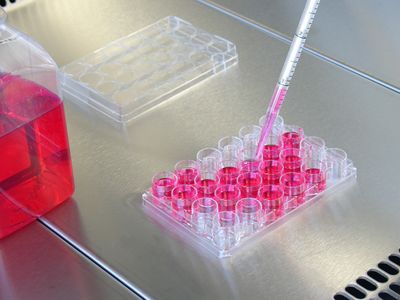ABOVE: Paul Berg in 1980 National Library of Medicine
Genetic engineering uses enzymes to carefully alter genetic material. This line of study has led to hardier and healthier food crops, the mass production of insulin, and novel vaccines, and it’s all possible because of the work done by biochemist Paul Berg, who became the first to use recombinant DNA. Berg died on February 15 at 96 years old.
Born to Jewish Russian immigrants in Brooklyn, New York on June 30, 1926, Berg developed a love for science during middle school, according to The New York Times. In his Nobel Foundation biography, Berg talks about being inspired to pursue a career in research by Sophie Wolfe, who managed the supply room for his high school science classes and encouraged him to do the “addicting” work of finding answers himself.
Berg enlisted in the US Navy after high school, during the height of World War II. He was able to take biochemistry classes at Penn State University while waiting for his naval training. Berg returned to Penn State after the war and received a biochemistry degree in 1948. He then attended graduate school at Western Reserve University (now known as Case Western Reserve University), earning a PhD in biochemistry in 1952. In his Nobel biography, Berg states that he hadn’t heard of the school before attending it and became aware of its existence—and ultimately decided to attend—based on papers published by researchers there.
His graduate work focused on enzymes. He broke ground by discovering the necessity of vitamin B12 and folic acid in the process known as one-carbon metabolism, which occurs in mitochondria and cytoplasm and enables many cellular functions.
Berg’s career became nomadic after grad school for a few years, and he worked in Copenhagen, Cambridge, and St. Louis. During this time, he discovered an enzyme necessary for nucleic acid assembly, which shifted his focus to genetics.
In 1959, he took a job at Stanford University’s burgeoning biochemistry department, which became his primary research residence for the rest of his career. He assumed many roles at the university, including chairman of the department for five years in the early 1970s and director of the Beckman Center for Molecular and Genetic Medicine from 1985 until 2000, when he retired as professor emeritus.
“I cannot overstate Paul’s brilliance, compassion and enthusiasm for discovery,” Stanford School of Medicine dean Lloyd Minor said in the university’s announcement of Berg’s death. “The joy of discovery motivated Paul throughout his career, and he generously gave his time to instill that joy in countless many.”
The research that Berg would become most well-known for was published in 1972. His team successfully inserted a DNA segment from Escherichia coli into the genome of simian virus 40 and produced a functional gene. This development became the dawn of genetic engineering and has allowed scientists to make advancements in agriculture, medicine, and more.
Once achieved, however, he urged scientists to proceed with caution until it was determined that the technique was safe. Throughout the 1970s and beyond, he gathered with other scientists to try to get a handle on the technology and to advocate for its responsible use.
In 1980, Berg received one-half of the Nobel Prize in Chemistry “for his fundamental studies of the biochemistry of nucleic acids, with particular regard to recombinant-DNA,” and Walter Gilbert and Federick Sanger shared the other half.
Along with the Nobel Prize, Berg received many accolades throughout his career. In 1966, he was elected into the National Academy of Sciences and the American Academy of Arts and Sciences. Then-President Ronald Reagan presented Berg with the National Medal of Science in 1983. A collection of his work known as “The Paul Berg Papers” has been curated by the National Library of Medicine.
His wife of nearly 75 years preceded him in death in 2021. His son, John, survives him.




